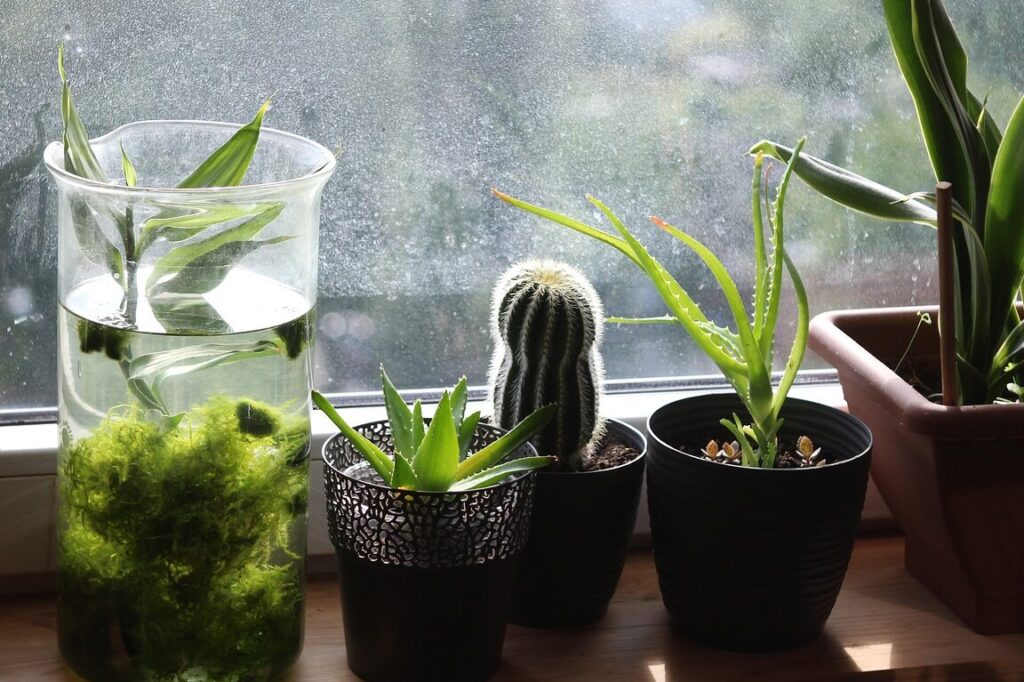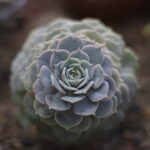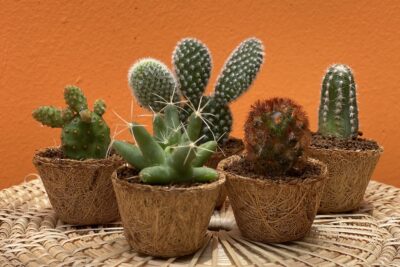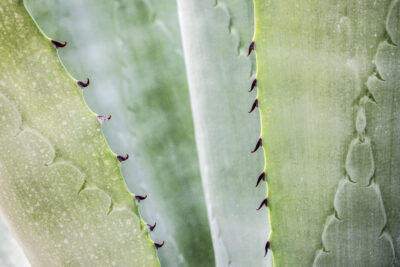
The Lifespan of Indoor Succulents: How Long Do They Typically Live?

Indoor succulents have gained immense popularity in recent years due to their unique appearance, low maintenance requirements, and ability to thrive in various indoor environments. These plants, characterized by their thick, fleshy leaves and ability to store water, can add a touch of natural beauty to any indoor space. As more and more people are incorporating these resilient plants into their homes and offices, it is natural to wonder about their lifespan and how long they typically live.
We will explore the lifespan of indoor succulents and delve into the factors that can impact their longevity. We will discuss the different types of succulents and their typical lifespan, as well as the care and maintenance practices that can help prolong their life. Additionally, we will address common misconceptions about succulents and provide tips on how to keep them healthy and thriving for as long as possible. Whether you are a succulent enthusiast or a beginner looking to add these beautiful plants to your indoor garden, this article will provide you with valuable insights on the lifespan of indoor succulents.
- Indoor succulents typically live for several years
- The lifespan of indoor succulents can vary depending on the species
- With proper care, indoor succulents can live for 5-10 years
- Providing the right amount of sunlight and water can help prolong the lifespan of indoor succulents
- Regularly repotting indoor succulents can help ensure their longevity
- Avoid overwatering indoor succulents to prevent root rot and extend their lifespan
- Pruning dead leaves and stems can promote the health and longevity of indoor succulents
- Protecting indoor succulents from extreme temperatures can help them live longer
- Keeping indoor succulents in well-draining soil can improve their lifespan
- Monitoring for pests and promptly treating infestations can help indoor succulents live longer
- Indoor succulents typically have a lifespan of several years
- The lifespan of indoor succulents can vary depending on the species they belong to
- When provided with proper care, indoor succulents can live for 5-10 years
- To prolong the lifespan of indoor succulents, it is important to give them the right amount of sunlight and water
- Regularly repotting indoor succulents can contribute to their longevity
- Overwatering should be avoided as it can lead to root rot and shorten the lifespan of indoor succulents
- Using well-draining soil is beneficial for the lifespan of indoor succulents
- Frequently Asked Questions
Indoor succulents typically live for several years
Indoor succulents are known for their ability to thrive in a variety of environments, but have you ever wondered how long they typically live? Understanding the lifespan of indoor succulents can help you better care for these plants and ensure their longevity.
Factors Affecting Lifespan
Several factors can influence the lifespan of indoor succulents. These include:
- Species: Different species of succulents have varying lifespans. Some may live for only a few years, while others can survive for several decades.
- Growing Conditions: The conditions in which you grow your indoor succulents play a crucial role in their lifespan. Factors such as light, temperature, humidity, and soil quality can impact their overall health and longevity.
- Care and Maintenance: Proper care and maintenance are essential for the longevity of indoor succulents. Regular watering, appropriate fertilizer application, and timely repotting can all contribute to their overall lifespan.
Average Lifespan of Indoor Succulents
While the lifespan of indoor succulents can vary, on average, these plants typically live for several years. With proper care and favorable growing conditions, many indoor succulents can thrive for five to ten years or even longer.
However, it's important to note that some succulents, particularly those that are more delicate or slow-growing, may have shorter lifespans. On the other hand, robust succulent species can live for several decades when provided with optimal care.
 Easy-care succulents: A guide to slow-growing, low-maintenance plants
Easy-care succulents: A guide to slow-growing, low-maintenance plantsExtending the Lifespan of Indoor Succulents
If you're looking to extend the lifespan of your indoor succulents, here are a few tips:
- Provide Adequate Light: Succulents need plenty of sunlight to thrive. Place them in a location where they can receive bright, indirect light for at least six hours a day.
- Water Properly: Overwatering is one of the most common causes of succulent death. Allow the soil to dry out completely between watering sessions, and be mindful of the individual watering needs of different succulent species.
- Use Well-Draining Soil: Succulents prefer soil that drains well and doesn't hold excess moisture. Choose a potting mix specifically formulated for succulents or add perlite or sand to improve drainage.
- Avoid Overfertilization: While succulents do require some nutrients, it's important not to overfertilize. Use a balanced fertilizer specifically formulated for succulents and follow the recommended dosage instructions.
- Monitor for Pests and Diseases: Regularly inspect your indoor succulents for signs of pests or diseases. If you notice any issues, take prompt action to address them and prevent further damage.
By following these guidelines and providing the care your indoor succulents need, you can help ensure their longevity and enjoy their beauty for years to come.
The lifespan of indoor succulents can vary depending on the species
When it comes to indoor succulents, the lifespan can vary significantly depending on the species. Some species of succulents can live for many years, while others may have a shorter lifespan. Understanding the factors that can affect the lifespan of indoor succulents can help you provide the right care and ensure their longevity.
Factors that can affect the lifespan of indoor succulents
Several factors can influence how long indoor succulents live. These factors include:
- Species: Each species of succulent has its own lifespan. Some species are known to live for several decades, while others may only survive for a few years.
- Growing conditions: The growing conditions you provide for your indoor succulents play a vital role in their lifespan. Factors such as light, temperature, humidity, and soil quality can impact their overall health and longevity.
- Watering: Overwatering or underwatering can be detrimental to the lifespan of succulents. These plants are adapted to survive in arid conditions and prefer infrequent but deep watering.
- Pests and diseases: Succulents can be susceptible to pests and diseases, which can impact their health and lifespan. Regular inspection and prompt treatment can help prevent any issues from becoming severe.
- Propagation: Many succulents can be propagated through various methods, such as leaf or stem cuttings. By propagating new plants, you can ensure the continuation of your favorite indoor succulents even if the original plant reaches the end of its lifespan.
Typical lifespan of some popular indoor succulents
While the lifespan of indoor succulents can vary, here are the typical lifespans of some popular species:
- Jade Plant (Crassula ovata): Jade plants can live for several decades with proper care.
- Aloe Vera (Aloe barbadensis): Aloe vera plants can live for 10 to 25 years.
- Echeveria: Echeveria succulents can live for 3 to 10 years, depending on the species.
- Haworthia: Haworthia species can live for several years, with some reaching up to 20 years or more.
- Sansevieria (Snake Plant): Snake plants can live for many years, often exceeding a decade.
It's important to note that these are just general guidelines, and individual plants may have variations in their lifespan. By providing the right care and attention, you can help prolong the lifespan of your indoor succulents and enjoy their beauty for years to come.
 Preventing Succulent Stretching: Tips for Compact Growth
Preventing Succulent Stretching: Tips for Compact GrowthWith proper care, indoor succulents can live for 5-10 years
Indoor succulents have gained popularity in recent years due to their unique and low-maintenance nature. These plants, which store water in their leaves, stems, and roots, are well-suited for indoor environments where they can thrive with minimal attention. However, just like any other living organism, succulents have a finite lifespan.
Factors Affecting the Lifespan of Indoor Succulents
The lifespan of indoor succulents can vary depending on several factors. One of the most crucial factors is the level of care they receive. Succulents require proper watering, adequate sunlight, and well-draining soil to survive and thrive.
Overwatering is a common mistake that can lead to the demise of indoor succulents. Their roots are susceptible to rot when exposed to excessive moisture for prolonged periods. On the other hand, underwatering can cause the leaves to shrivel and eventually die.
Sunlight is another vital factor in the lifespan of indoor succulents. While they do well in bright light, direct sunlight for extended periods can scorch their leaves. Finding the right balance between light exposure and shade is crucial to their longevity.
The type of soil used also plays a role in the lifespan of indoor succulents. Well-draining soil allows excess water to escape, preventing root rot and ensuring healthy growth.
Typical Lifespan of Indoor Succulents
With proper care, indoor succulents can live for an average of 5-10 years. However, it's important to note that this is just an estimate, and some succulents may live longer or shorter lives depending on various factors.
 Can Frozen Succulents Bounce Back After Suffering Cold Damage?
Can Frozen Succulents Bounce Back After Suffering Cold Damage?Some species of succulents have a naturally longer lifespan than others. For instance, the Jade Plant (Crassula ovata) has been known to live for several decades under ideal conditions. On the other hand, certain succulents, like the Echeveria species, have a shorter lifespan of around 3-5 years.
Extending the Lifespan of Indoor Succulents
If you want to maximize the lifespan of your indoor succulents, there are a few tips to keep in mind:
- Provide the right amount of water: Water your succulents only when the soil is completely dry, and be cautious not to overwater them.
- Ensure proper sunlight exposure: Place your succulents in a location where they receive bright, indirect sunlight for several hours a day.
- Use well-draining soil: Opt for a well-draining succulent soil mix or add perlite to regular potting soil to improve drainage.
- Monitor for pests: Keep an eye out for common succulent pests like mealybugs and spider mites. If detected early, take appropriate measures to eliminate them.
- Re-pot when necessary: As your succulents grow, they may outgrow their current pots. Repot them into larger containers to provide ample space for their roots.
By following these guidelines, you can help ensure that your indoor succulents live a long and healthy life.
Providing the right amount of sunlight and water can help prolong the lifespan of indoor succulents
Indoor succulents have become increasingly popular as houseplants due to their unique beauty and low maintenance needs. These desert plants are known for their ability to store water in their leaves, making them resilient and adaptable to various environments. However, like any living organism, indoor succulents have a lifespan that is influenced by several factors.
1. Species
The lifespan of indoor succulents can vary depending on the species. Some succulents, such as the Jade Plant (Crassula ovata) and Aloe Vera (Aloe barbadensis), can live for decades with proper care. Other species, like the Echeveria and Sedum varieties, typically have a lifespan of 3-5 years. It is essential to research the specific species of succulent you own to understand its typical lifespan.
2. Growing Conditions
The lifespan of indoor succulents is greatly influenced by the growing conditions provided. Succulents thrive in bright, indirect sunlight. Placing them near a sunny window or using artificial grow lights can help ensure they receive adequate light. Additionally, succulents prefer well-draining soil to prevent root rot. Overwatering is a common cause of death for succulents, so it is crucial to allow the soil to dry out completely between waterings.
 Reviving Dead Succulent Roots: A Step-by-Step Guide to Restore Health
Reviving Dead Succulent Roots: A Step-by-Step Guide to Restore Health3. Watering and Drought Tolerance
Succulents are adapted to survive in arid environments, making them more tolerant of drought conditions than excessive moisture. Overwatering can lead to root rot and other diseases, which significantly reduces the lifespan of indoor succulents. It is important to establish a watering routine that allows the soil to dry out completely between waterings. The frequency of watering will depend on factors such as the size of the pot, humidity levels, and the specific succulent species.
4. Pest and Disease Control
Pests and diseases can also affect the lifespan of indoor succulents. Common pests that can infest succulents include mealybugs, scale insects, and spider mites. Regularly inspecting your plants and taking prompt action at the first sign of infestation can help prevent the spread of pests and minimize damage. Additionally, proper ventilation and avoiding overcrowding can reduce the risk of diseases such as fungal infections.
5. Propagation
One way to extend the lifespan of your indoor succulents is through propagation. Many succulents can be easily propagated by taking stem or leaf cuttings and allowing them to root in a suitable growing medium. By propagating your succulents, you can create new plants and essentially clone the parent plant, ensuring its genetic material lives on even if the original plant begins to decline.
Overall, the lifespan of indoor succulents is influenced by various factors such as species, growing conditions, watering practices, pest and disease control, and propagation. By providing the right amount of sunlight, water, and care, you can help prolong the lifespan of your indoor succulents and enjoy their beauty for years to come.
Regularly repotting indoor succulents can help ensure their longevity
Indoor succulents are popular houseplants due to their unique and exotic appearance, low maintenance requirements, and ability to thrive in various indoor environments. However, like any other living organism, succulents have a limited lifespan that can be extended with proper care and attention.
Understanding the Lifespan of Indoor Succulents
The lifespan of indoor succulents can vary depending on several factors, including the species, growing conditions, and the care provided by the owner. While some succulents can live for several decades, others have a shorter lifespan of a few years.
 Perennial Succulents: Low-Maintenance Plants for Easy Care
Perennial Succulents: Low-Maintenance Plants for Easy CareSpecies: Different succulent species have different lifespans. Some long-living indoor succulents include the Jade Plant (Crassula ovata) and the Aloe Vera (Aloe barbadensis), which can live for several decades with proper care. On the other hand, certain succulents, such as the Echeveria spp., have a shorter lifespan of around 3-5 years.
Growing Conditions: The conditions in which succulents are grown indoors play a crucial role in their lifespan. Succulents thrive in bright, indirect light and prefer well-draining soil. Overexposure to direct sunlight or keeping them in dark corners can negatively affect their growth and lifespan. Additionally, overwatering or allowing the roots to sit in waterlogged soil can lead to root rot and ultimately shorten the succulent's lifespan.
Care and Maintenance: Regular care and maintenance are essential for prolonging the lifespan of indoor succulents. This includes proper watering, fertilizing, and repotting when needed. Over time, succulents may outgrow their containers, and repotting them into larger pots with fresh soil can provide them with the necessary nutrients and space for continued growth.
Tips for Extending the Lifespan of Indoor Succulents
Here are some tips to help you extend the lifespan of your indoor succulents:
- Provide Adequate Lighting: Place your succulents near a window with bright, indirect light to ensure they receive the necessary amount of light for photosynthesis.
- Water Properly: Succulents have unique water requirements and prefer to be slightly underwatered rather than overwatered. Allow the soil to dry out completely between waterings.
- Use Well-Draining Soil: Plant your succulents in a well-draining soil mix specifically formulated for succulents. This helps prevent root rot and allows excess water to drain away.
- Avoid Overfertilizing: While succulents do benefit from occasional fertilization, it is important not to overdo it. Use a balanced, diluted fertilizer and follow the recommended dosage.
- Regularly Repot: As your indoor succulents grow, monitor their root health and repot them into larger containers when necessary. This promotes healthy growth and minimizes the risk of root-bound plants.
By following these tips and providing the necessary care, you can help extend the lifespan of your indoor succulents and enjoy their beauty for many years to come.
Avoid overwatering indoor succulents to prevent root rot and extend their lifespan
Indoor succulents have become quite popular among plant enthusiasts due to their unique and low-maintenance nature. These plants, which store water in their leaves, stems, or roots, are known for their ability to survive in arid conditions. However, it is essential to understand the lifespan of indoor succulents to ensure their longevity.
 Protecting Outdoor Succulents in Heavy Rain: Essential Tips
Protecting Outdoor Succulents in Heavy Rain: Essential TipsUnderstanding the Lifespan of Indoor Succulents
The lifespan of indoor succulents can vary depending on various factors, including the species, care provided, and environmental conditions. While some succulents can live for several years, others may have a shorter lifespan.
One crucial factor to consider is the growth habit of succulents. Some succulents are monocarpic, meaning they flower once in their lifetime and then die. This includes popular species like the Agave and Aeonium. On the other hand, most succulents are polycarpic, which means they can produce multiple flowers and live for many years.
Another vital aspect that influences the lifespan of indoor succulents is the care provided. One of the most common mistakes made by succulent owners is overwatering. Succulents are adapted to survive in arid conditions and can store water in their leaves and stems. Overwatering can lead to root rot, which can be fatal for succulents.
It is crucial to establish a watering routine that allows the soil to dry out between watering sessions. This ensures that the roots do not remain constantly wet, preventing the development of root rot. Additionally, using well-draining soil and pots with drainage holes can further aid in preventing overwatering.
Tip: Before watering your succulents, always check the moisture level of the soil by inserting your finger about an inch into the soil. If it feels dry, it's time to water.
Maximizing the Lifespan of Indoor Succulents
To extend the lifespan of your indoor succulents, it is essential to provide them with the optimal growing conditions. Here are a few tips to maximize their lifespan:
- Provide Adequate Light: Succulents thrive in bright light conditions. Place them near a south-facing window or provide them with artificial grow lights to ensure they receive enough light.
- Maintain Proper Temperature: Most succulents prefer warm temperatures ranging between 60°F (15°C) to 80°F (27°C). Avoid exposing them to extreme cold or hot temperatures.
- Avoid Overfertilizing: Succulents have low nutrient requirements. Overfertilizing can lead to burning of the roots. Use a balanced, diluted fertilizer specifically formulated for succulents and follow the instructions carefully.
- Regularly Remove Dead Leaves: As succulents age, their lower leaves may wither and die. It is important to remove these dead leaves to prevent the growth of mold or pests.
- Monitor for Pests: Keep an eye out for common succulent pests like mealybugs and spider mites. Regularly inspect your plants, and if you notice any signs of infestation, take appropriate measures to control and eliminate the pests.
By following these guidelines and providing the necessary care, you can help ensure that your indoor succulents live a long and healthy life, bringing beauty and joy to your indoor space.
 How to Safely Clean Succulent Leaves: A Step-by-Step Guide
How to Safely Clean Succulent Leaves: A Step-by-Step GuidePruning dead leaves and stems can promote the health and longevity of indoor succulents
Indoor succulents have gained immense popularity in recent years due to their unique beauty and low maintenance requirements. These resilient plants are known for their ability to store water in their leaves, making them perfect for busy individuals or those lacking a green thumb.
While indoor succulents are relatively easy to care for, it's important to understand their lifespan and how to promote their health and longevity. One key aspect of maintaining healthy indoor succulents is pruning dead leaves and stems.
Why is pruning important for indoor succulents?
Pruning is the act of removing dead or decaying leaves and stems from a plant. When it comes to indoor succulents, pruning serves several important purposes:
- Promotes overall plant health: Removing dead or dying parts of the succulent prevents the spread of diseases or pests that may be present. Pruning also encourages new growth and helps the plant focus its energy on healthy parts.
- Enhances aesthetics: Pruning helps maintain the desired shape and appearance of indoor succulents. Regularly removing dead leaves and stems ensures that the plant remains visually appealing and prevents it from becoming overgrown or lopsided.
- Prevents rot: Succulents are prone to rot if overwatered or exposed to excessive moisture. By pruning dead parts, you reduce the risk of rot by eliminating areas where water can accumulate and cause damage.
How to prune indoor succulents
Pruning indoor succulents is a straightforward process that requires minimal tools and effort. Here's a simple step-by-step guide:
- Inspect the succulent: Carefully examine the plant to identify any dead or decaying leaves and stems. These are typically discolored, wilted, or mushy in texture.
- Prepare your tools: Use a pair of clean and sharp pruning shears or scissors. It's important to sanitize the tools before and after pruning to prevent the spread of any potential diseases.
- Begin pruning: Cut off the dead leaves or stems as close to the base as possible. Make clean cuts to avoid causing unnecessary damage to the plant.
- Dispose of the pruned parts: Collect the pruned parts and dispose of them in a sealed bag or container. Do not compost them, as this can potentially introduce diseases back into your succulent or other plants.
- Monitor and repeat: Regularly check your indoor succulent for any new signs of dead or decaying parts. Prune as necessary to maintain its health and appearance.
Remember, pruning should be done as needed and not excessively. Avoid removing healthy parts of the succulent, as this can harm its overall well-being.
By incorporating pruning into your routine care for indoor succulents, you can help extend their lifespan and ensure they thrive in your home or office environment.
 Fertilizing Succulents: To Do or Not in the Growing Season?
Fertilizing Succulents: To Do or Not in the Growing Season?Protecting indoor succulents from extreme temperatures can help them live longer
Indoor succulents have gained popularity in recent years due to their unique beauty and low maintenance requirements. These desert plants have adapted to survive in harsh conditions, making them a perfect choice for those who lack a green thumb. However, like any living organism, indoor succulents also have a lifespan, and understanding how long they typically live can help you provide the best care for your plants.
One crucial factor that can significantly impact the lifespan of indoor succulents is temperature. While these plants are known for their ability to withstand dry environments, extreme temperatures can be detrimental to their health. Succulents thrive in moderate temperatures, ideally between 60 to 80 degrees Fahrenheit (15 to 26 degrees Celsius).
1. Protecting from cold
Exposing succulents to freezing temperatures can cause irreparable damage, leading to their premature death. It is crucial to keep your indoor succulents away from drafty windows, as they can experience temperature drops during the winter months. Additionally, avoid placing them near air conditioning units or vents that blow cold air directly onto the plants.
2. Shielding from heat
While succulents are known for their ability to withstand heat, excessively high temperatures can be harmful to their longevity. Protect your indoor succulents from direct sunlight during the hottest parts of the day, especially during scorching summer months. Consider using shades or curtains to filter the intense sunlight and prevent your plants from becoming overheated.
 Troubleshooting Tips: How to Fix a Tall and Falling Over Succulent
Troubleshooting Tips: How to Fix a Tall and Falling Over Succulent3. Providing temperature consistency
Succulents prefer a consistent temperature environment rather than sudden fluctuations. Avoid placing them near heat sources such as radiators or fireplaces, as the constant exposure to high temperatures can stress the plants. Similarly, keep them away from air conditioning units that may blow cold air intermittently.
By taking these precautions and ensuring a suitable temperature range, you can extend the lifespan of your indoor succulents. However, it is important to note that the lifespan of succulents can vary depending on the species, care provided, and individual plant health. Some succulents can live for several years, while others may have a shorter lifespan.
Remember to observe your plants closely and provide them with proper care, including adequate sunlight, well-draining soil, and regular watering. With the right conditions and care, your indoor succulents can thrive and bring beauty to your living space for years to come.
Keeping indoor succulents in well-draining soil can improve their lifespan
Indoor succulents have gained popularity in recent years due to their unique beauty and low maintenance requirements. However, many succulent owners are often left wondering about the lifespan of these plants. How long do indoor succulents typically live?
The lifespan of indoor succulents can vary depending on various factors such as species, care routine, and environmental conditions. While some succulents have been known to live for several decades, others may have a shorter lifespan.
 Understanding Winter Leaf Drop: Why Do Succulent Leaves Fall Off?
Understanding Winter Leaf Drop: Why Do Succulent Leaves Fall Off?One crucial factor in ensuring the longevity of indoor succulents is the type of soil they are planted in. Succulents thrive in well-draining soil that allows excess water to escape quickly. This helps prevent root rot, a common issue that can significantly shorten the lifespan of these plants.
When choosing soil for your indoor succulents, opt for a mix specifically formulated for cacti and succulents. These mixes typically contain a combination of soil, sand, and perlite, providing the ideal balance of drainage and moisture retention.
Another important aspect to consider is the frequency and amount of water you provide to your indoor succulents. Overwatering is one of the leading causes of succulent death. It can lead to root rot and create a favorable environment for pests and diseases.
To ensure the longevity of your indoor succulents, water them sparingly but thoroughly. Allow the soil to dry out completely between waterings, and make sure to discard any excess water that accumulates in the drainage tray.
Additionally, providing adequate sunlight is crucial for the health and longevity of indoor succulents. Most succulents require bright, indirect light to thrive. Place them near a sunny window or provide artificial grow lights if natural light is limited.
Regularly inspect your indoor succulents for signs of pests or diseases. Common pests that can affect succulents include mealybugs, scale insects, and spider mites. If you notice any signs of infestation, take immediate action to prevent further damage to your plants.
Lastly, be mindful of the temperature and humidity levels in your home. Succulents generally prefer warm and dry conditions, so avoid placing them near drafty windows or in excessively humid areas.
The lifespan of indoor succulents can be extended by providing them with the right conditions and care. Proper soil drainage, appropriate watering, adequate sunlight, and pest prevention are key factors in ensuring the longevity of these beautiful plants.
Monitoring for pests and promptly treating infestations can help indoor succulents live longer
When it comes to the lifespan of indoor succulents, proper care and attention are essential. One important aspect of maintaining healthy succulents is monitoring for pests and promptly treating infestations. Pests can wreak havoc on your succulents, causing damage that can ultimately shorten their lifespan.
There are several common pests that can pose a threat to indoor succulents, such as mealybugs, aphids, and spider mites. These pests can quickly multiply and spread, causing significant damage to the leaves and stems of your plants. If left untreated, they can weaken the succulents and eventually lead to their demise.
So, how can you monitor for pests and effectively treat infestations?
1. Regularly inspect your succulents
Make it a habit to regularly examine your indoor succulents for any signs of pests. Look closely at the stems, leaves, and soil surface for any unusual spots, webbing, or tiny crawling insects. Early detection is crucial in preventing a small infestation from becoming a full-blown problem.
2. Remove pests manually
If you spot any pests on your succulents, take immediate action to remove them manually. Use a pair of tweezers or a cotton swab dipped in rubbing alcohol to carefully remove pests from the leaves and stems. Be thorough in your approach to ensure you eliminate all visible pests.
3. Use organic pest control methods
For larger infestations or persistent pest problems, consider using organic pest control methods. Neem oil, insecticidal soap, or a mixture of water and dish soap can be effective in eliminating pests from your succulents. Follow the instructions on the product labels and apply the treatments as directed.
4. Quarantine infested plants
If you notice a severe infestation on one of your succulents, it's important to quarantine the affected plant. This will prevent the pests from spreading to other healthy succulents in your collection. Keep the infested plant in isolation until you have successfully eradicated the pests and the succulent has recovered.
5. Maintain proper growing conditions
Remember that prevention is key when it comes to pest control. Maintaining proper growing conditions for your indoor succulents can help them stay healthy and more resistant to pests. Provide adequate sunlight, well-draining soil, and avoid overwatering, as these factors can make succulents more susceptible to pest infestations.
By regularly monitoring for pests and promptly treating infestations, you can significantly increase the lifespan of your indoor succulents. With proper care and attention, your succulents can thrive for many years, bringing beauty and greenery to your indoor space.
Indoor succulents typically have a lifespan of several years
Indoor succulents are known for their resilience and ability to thrive in various conditions. The lifespan of these unique plants can vary depending on various factors such as species, care, and environmental conditions. Generally, indoor succulents have a lifespan of several years, making them a long-lasting addition to your indoor garden.
Factors affecting the lifespan of indoor succulents
Several key factors can influence the lifespan of indoor succulents. These factors include:
- Species: Different species of succulents have varying lifespans. Some species, such as Echeveria and Aloe Vera, can live for several decades when provided with proper care. On the other hand, certain species have shorter lifespans, ranging from a few years to a decade.
- Care: The level of care you provide to your indoor succulents plays a significant role in determining their lifespan. Succulents require specific care, including well-draining soil, adequate sunlight, and proper watering. Neglecting these care requirements can lead to a shorter lifespan for your plants.
- Environmental conditions: The environment in which your indoor succulents are kept can impact their lifespan. Succulents thrive in bright, indirect sunlight and moderate temperatures. Extreme conditions such as excessive heat or cold can stress the plants and shorten their lifespan.
Extending the lifespan of your indoor succulents
To ensure that your indoor succulents live a long and healthy life, consider the following tips:
- Provide proper lighting: Place your succulents near a window where they can receive bright, indirect sunlight. If natural light is limited, you can supplement it with artificial grow lights.
- Watering with caution: Succulents are drought-tolerant plants and prefer infrequent but deep watering. Overwatering can lead to root rot and ultimately shorten their lifespan. Allow the soil to dry out completely between waterings.
- Use well-draining soil: Ensure that your succulents are planted in a well-draining soil mix. This helps prevent waterlogged roots and promotes healthy growth.
- Monitor temperature: Keep your succulents in an environment with temperatures between 60°F and 80°F (15°C - 27°C). Avoid exposing them to extreme temperature fluctuations.
- Regularly inspect for pests: Check your indoor succulents for any signs of pests such as mealybugs or spider mites. These pests can weaken the plants and reduce their lifespan. If necessary, take appropriate measures to control and eliminate the pests.
By providing the right care and creating a suitable environment, you can significantly extend the lifespan of your indoor succulents. Enjoy the beauty and longevity of these captivating plants as they thrive in your indoor space!
The lifespan of indoor succulents can vary depending on the species they belong to
Indoor succulents are a popular choice for plant enthusiasts due to their unique appearance and low maintenance requirements. However, one question that often arises is how long these captivating plants typically live. The lifespan of indoor succulents can vary greatly depending on the specific species they belong to.
Factors influencing the lifespan of indoor succulents
Several factors play a role in determining the lifespan of indoor succulents. These factors include:
- Species: Different species of succulents have varying lifespans. Some species, such as Sempervivum and Haworthia, are known to live for many years, while others, like Echeveria or Sedum, have a shorter lifespan.
- Environmental conditions: The conditions in which you keep your indoor succulents can greatly impact their lifespan. Factors such as light, temperature, humidity, and air circulation all play a role in their overall health and longevity.
- Proper care: Providing your succulents with the right care is essential for their long-term survival. This includes watering them appropriately, providing well-draining soil, and avoiding overwatering, which can lead to root rot.
- Pests and diseases: Succulents are generally resistant to pests and diseases. However, if they are not properly cared for or if their environment becomes susceptible to pests, such as mealybugs or aphids, it can significantly affect their lifespan.
Typical lifespan of popular indoor succulents
While it is important to note that the lifespan of indoor succulents can vary, here is a general idea of how long some popular species typically live:
- Sempervivum: Also known as "hens and chicks," Sempervivum succulents can live for several years, with some varieties living up to 10 years or more.
- Haworthia: These small, rosette-shaped succulents can live for many years with proper care, often reaching a lifespan of 5 to 10 years.
- Echeveria: Echeveria succulents are known for their stunning rosette shape and vibrant colors. They typically live for 3 to 5 years.
- Sedum: Sedum succulents come in a variety of shapes and sizes. They generally have a lifespan of 3 to 7 years.
Keep in mind that these are just general estimates, and individual plants may vary. With proper care and attention to their specific needs, indoor succulents can thrive and bring beauty to your living space for many years.
When provided with proper care, indoor succulents can live for 5-10 years
Indoor succulents have gained popularity as low-maintenance houseplants, thanks to their unique appearance and ability to thrive in dry conditions. However, like any living organism, they have a limited lifespan. Understanding the typical lifespan of indoor succulents is crucial for their care and maintenance.
Factors affecting the lifespan of indoor succulents
Several factors contribute to the lifespan of indoor succulents:
- Species: Different succulent species have varying lifespans. Some species, such as the Agave and Aloe vera, can live for several decades, while others may only survive a few years.
- Environmental conditions: Indoor succulents thrive in bright, indirect light and well-draining soil. If these conditions are not met, their lifespan may be shortened.
- Watering practices: Overwatering is one of the leading causes of succulent death. These plants are adapted to arid environments and require infrequent watering. Improper watering can lead to root rot and ultimately shorten their lifespan.
- Pests and diseases: Succulents can be prone to certain pests like mealybugs or diseases like fungal infections. Regular inspection and appropriate pest control measures can help prolong their lifespan.
How long do indoor succulents typically live?
When provided with proper care, indoor succulents can live for 5-10 years on average. However, with ideal conditions and meticulous care, some species have been known to survive for several decades.
It's important to note that the lifespan of a succulent may also depend on its growth cycle. Some succulents, like the Hens and Chicks (Sempervivum), produce offsets or "pups" that can carry on the plant's legacy even after the original rosette dies.
Increasing the lifespan of indoor succulents
To ensure your indoor succulents live their longest, consider the following tips:
- Provide proper lighting: Place your succulents in a location with bright, indirect sunlight to promote healthy growth.
- Use well-draining soil: Succulents prefer soil that allows excess water to drain quickly, preventing root rot.
- Water sparingly: Only water your succulents when the soil is completely dry. Overwatering can be detrimental to their health.
- Monitor for pests and diseases: Regularly inspect your succulents for any signs of pests or diseases, and take appropriate measures to control them.
- Practice proper propagation: If your succulent produces offsets or "pups," learn how to propagate them properly to ensure the continuation of their lineage.
By implementing these care practices, you can extend the lifespan of your indoor succulents and enjoy their beauty for years to come.
To prolong the lifespan of indoor succulents, it is important to give them the right amount of sunlight and water
Indoor succulents are a popular choice for plant enthusiasts due to their unique appearance and low maintenance requirements. However, many people wonder about the lifespan of these beautiful plants and how long they typically live.
One of the key factors in prolonging the lifespan of indoor succulents is providing them with the right amount of sunlight. Succulents thrive in bright light conditions, so it is important to place them near a window where they can receive adequate sunlight. However, be cautious of exposing them to direct sunlight for prolonged periods as it can cause sunburn and damage the plant. Finding the right balance is crucial to ensure their longevity.
Another crucial aspect to consider is watering. Succulents store water in their leaves, stems, and roots, making them highly efficient in drought-like conditions. Overwatering is a common mistake that can lead to root rot and ultimately result in the plant's death. It is best to water succulents sparingly, allowing the soil to dry out completely before watering again. The frequency of watering will depend on various factors such as the type of succulent, the size of the pot, and the surrounding humidity levels.
Furthermore, the type of soil used is also essential for the lifespan of indoor succulents. A well-draining soil mix specifically designed for succulents and cacti is recommended. This type of soil allows excess water to drain out quickly, preventing the roots from sitting in water, which can cause root rot.
Additionally, succulents benefit from occasional fertilization. However, it is important not to overdo it. Using a balanced, water-soluble fertilizer diluted to half-strength can provide the necessary nutrients without overwhelming the plant. Fertilizing every few months during the growing season is usually sufficient to promote healthy growth and prolong their lifespan.
Lastly, regular maintenance is crucial for the long-term health of indoor succulents. Remove any dead or dying leaves to prevent the spread of diseases and pests. Inspect the plant regularly for signs of pests such as aphids, mealybugs, or spider mites, and take appropriate action if necessary. Proper care and attention will ensure that your indoor succulents live a long and healthy life.
The lifespan of indoor succulents can vary depending on various factors such as the care provided, the type of succulent, and environmental conditions. By providing them with the right amount of sunlight, watering sparingly, using well-draining soil, occasional fertilization, and regular maintenance, you can extend the lifespan of your indoor succulents and enjoy their beauty for years to come.
Regularly repotting indoor succulents can contribute to their longevity
Indoor succulents are known for their ability to thrive in a variety of environments, making them a popular choice for plant lovers. However, despite their reputation for being low-maintenance and resilient, it's essential to understand that indoor succulents do have a lifespan.
In order to ensure the health and longevity of your indoor succulents, one crucial practice is regularly repotting them. Repotting involves transferring your succulents from their current container to a larger one, providing them with fresh soil and room to grow.
Why is repotting important for the lifespan of indoor succulents?
Repotting plays a significant role in the overall health and lifespan of indoor succulents for several reasons:
- Soil replenishment: Over time, the nutrients in the soil can become depleted, which can hinder the growth and health of your succulents. Repotting allows you to refresh the soil, providing your plants with the necessary nutrients to thrive.
- Root development: As your succulents grow, their root systems will also expand. Repotting provides them with more space for their roots to develop and spread, encouraging healthier growth and preventing them from becoming root-bound.
- Preventing disease and pests: Old potting soil can become a breeding ground for pests and diseases. By repotting your indoor succulents, you can eliminate any potential threats and create a clean and disease-free environment for your plants.
When should you repot your indoor succulents?
Knowing when to repot your indoor succulents is crucial. Here are a few signs that indicate it's time for a fresh pot:
- Tight root growth: If you notice that the roots are tightly packed within the pot and there is little room for them to expand, it's time to repot your succulent.
- Slow growth or wilting: If your succulent is showing signs of slow growth, wilting, or yellowing leaves, it may be a sign that it needs more space or fresh soil.
- Overflowing the pot: If your succulent has outgrown its current container and is starting to overflow or topple over, it's a clear indication that repotting is necessary.
How to repot your indoor succulents:
Follow these steps to repot your indoor succulents and ensure their longevity:
- Choose the right pot: Select a pot that is slightly larger than the current one and has drainage holes at the bottom to prevent overwatering.
- Prepare the new soil: Use a well-draining succulent soil mix or create your own by combining potting soil, perlite, and sand.
- Carefully remove the succulent: Gently loosen the soil around the succulent and carefully lift it out of its current pot.
- Inspect the roots: Examine the roots for any signs of damage or rot. Trim away any unhealthy roots with clean, sharp scissors.
- Place in the new pot: Position the succulent in the center of the new pot and fill in the gaps with the prepared soil mix. Avoid burying the stem too deep.
- Water and settle: Give your newly repotted succulent a thorough watering, allowing the water to drain out completely. Allow the plant to settle in its new pot for a few days before resuming regular care.
By following these repotting guidelines, you can help prolong the lifespan of your indoor succulents and ensure they continue to thrive for years to come.
Overwatering should be avoided as it can lead to root rot and shorten the lifespan of indoor succulents
When it comes to caring for indoor succulents, one of the most important factors to consider is the watering routine. Overwatering can have a detrimental effect on the lifespan of these beautiful plants.
What is root rot?
Root rot is a condition that occurs when the roots of a plant are constantly sitting in water or damp soil. This excess moisture creates the perfect environment for harmful fungi and bacteria to thrive, leading to the decay and death of the roots.
Why is root rot a concern for indoor succulents?
Succulents are adapted to survive in arid and dry conditions, making them highly susceptible to root rot caused by overwatering. These plants have evolved to store water in their leaves, stems, or roots, allowing them to withstand long periods of drought. However, if they are consistently exposed to too much water, their specialized water storage structures can become overwhelmed, leading to root rot.
How does overwatering shorten the lifespan of indoor succulents?
Overwatering not only causes root rot but also disrupts the overall health and vitality of the plant. When the roots are constantly saturated, they are unable to absorb oxygen properly, leading to suffocation and eventual death. Additionally, the excess moisture can lead to the development of mold and fungus on the plant's leaves and stems, further weakening its immune system.
How to avoid overwatering indoor succulents?
- Ensure that the soil is completely dry before watering again. Stick your finger into the soil about an inch deep to check for moisture.
- Use a well-draining soil mix specifically formulated for succulents and cacti. This type of soil allows excess water to flow out of the pot, preventing waterlogged conditions.
- Water your succulents deeply but infrequently. Allow the soil to dry out completely between waterings, mimicking their natural habitat.
- Avoid using decorative pots without drainage holes, as they can trap excess water and increase the risk of overwatering.
Conclusion
Overwatering is one of the primary causes of shortened lifespan in indoor succulents. By understanding the risks associated with excess moisture and implementing proper watering practices, you can ensure that your succulents thrive and live a long, healthy life.
Indoor succulents are known for their resilience and ability to thrive in various environments. However, like any living organism, they have a limited lifespan. Understanding the typical lifespan of indoor succulents is crucial for their care and maintenance.
Factors Affecting Lifespan
Several factors can influence the lifespan of indoor succulents. The most significant ones include:
- Species: Different species of succulents have varying lifespans. Some may live for several years, while others may only survive for a few months.
- Environmental Conditions: The conditions in which you grow your indoor succulents play a vital role in their longevity. Factors such as light, temperature, humidity, and airflow can significantly impact their lifespan.
- Care and Maintenance: Proper care and maintenance practices, such as watering, fertilizing, and pruning, can extend the lifespan of indoor succulents. Neglecting these essential tasks can shorten their lifespan.
Typical Lifespan
The typical lifespan of indoor succulents can vary widely. Some succulents, like the jade plant (Crassula ovata), can live for decades if well cared for. On the other hand, certain echeveria varieties may only live for a few years.
It's important to note that succulents are not immortal, and their lifespan is finite. However, with proper care and attention, you can maximize their longevity.
Promoting Longevity
To promote the health and longevity of indoor succulents, it's essential to follow these practices:
- Provide Adequate Light: Succulents thrive in bright light, so place them near a south-facing window or provide artificial grow lights if necessary.
- Water Wisely: Succulents are adapted to arid environments and prefer infrequent watering. Allow the soil to dry out completely between waterings to prevent root rot.
- Use Well-Draining Soil: Succulents need soil that allows excess water to escape easily. Choose a well-draining potting mix specifically formulated for succulents.
- Avoid Overfertilizing: Succulents have low nutrient requirements. Use a balanced fertilizer diluted to half strength during the growing season, but avoid fertilizing during the dormant period.
- Prune Dead Leaves and Stems: Regularly remove dead or dying leaves and stems to prevent the spread of diseases and promote new growth.
By following these guidelines, you can increase the lifespan of your indoor succulents and enjoy their beauty for years to come.
Indoor succulents are a popular choice for plant enthusiasts due to their unique and low-maintenance nature. These plants have gained widespread popularity for their ability to thrive in various environments, including indoor spaces. However, like all living organisms, succulents have a finite lifespan that can be influenced by several factors.
One crucial factor that significantly impacts the lifespan of indoor succulents is temperature. Succulents, known for their ability to store water in their leaves and stems, are native to arid regions where extreme temperature fluctuations are common. Therefore, it is essential to protect them from extreme temperatures when grown indoors.
Extreme heat:
Exposing indoor succulents to prolonged periods of high temperatures can cause irreversible damage to their leaves and stems. The intense heat can cause the plant's cells to dehydrate, leading to wilting, discoloration, and eventually, death. To protect your succulents from extreme heat, ensure they are placed away from direct sunlight or windows that receive intense heat during the day. Consider using sheer curtains or blinds to filter the sunlight and create a more suitable environment for your plants.
Extreme cold:
While succulents are generally more tolerant of cold temperatures compared to other houseplants, prolonged exposure to extreme cold can be detrimental to their health. Freezing temperatures can cause the water stored in their leaves and stems to expand, leading to cellular damage and ultimately, their demise. To protect your indoor succulents from extreme cold, make sure they are placed in a location where the temperature remains above freezing. Avoid placing them near drafty windows or doors during the winter months.
Additionally, abrupt temperature changes can also be harmful to succulents. Sudden shifts from hot to cold or vice versa can shock the plants and disrupt their growth patterns. It is crucial to maintain a consistent temperature range for your indoor succulents to ensure their long-term health and longevity.
Summary:
By providing the right temperature conditions, you can help prolong the lifespan of your indoor succulents. Protecting them from extreme heat and cold will prevent damage to their leaves, stems, and overall health. Remember to maintain a consistent temperature range and avoid sudden temperature changes to ensure the well-being and longevity of your beloved succulents.
Using well-draining soil is beneficial for the lifespan of indoor succulents
When it comes to the lifespan of indoor succulents, one of the key factors to consider is the type of soil they are planted in. Succulents thrive in well-draining soil that allows water to flow through and prevents the roots from sitting in standing water. This is because succulents, being native to arid environments, have adapted to survive in conditions where water is scarce.
Using well-draining soil for your indoor succulents is important to mimic their natural habitat and promote their longevity. The ideal soil mixture for succulents should contain a combination of regular potting soil, coarse sand, and perlite. This combination allows excess water to drain away quickly, preventing root rot and other issues that can arise from overwatering.
Tip: You can also add some gravel or small rocks at the bottom of the pot before adding the soil mixture. This helps with further drainage and prevents water from pooling at the bottom.
Benefits of using well-draining soil for indoor succulents:
- Prevents root rot: Well-draining soil ensures that excess water doesn't accumulate around the roots, reducing the risk of root rot. This is crucial for the overall health and lifespan of your indoor succulents.
- Allows proper air circulation: The porous nature of well-draining soil allows air to circulate around the roots, preventing the soil from becoming overly compacted. Adequate air circulation promotes healthy root growth and prevents the buildup of harmful fungi or bacteria.
- Reduces the risk of pests: Overwatering and poor drainage can attract pests such as fungus gnats or root mealybugs. Well-draining soil deters these pests by creating an environment that is less favorable for their survival.
- Prevents nutrient deficiencies: When water sits around the roots for too long, it can lead to nutrient deficiencies as the excess water washes away essential nutrients. Well-draining soil ensures that water flows through quickly, allowing the roots to absorb the necessary nutrients.
By using well-draining soil, you can provide your indoor succulents with the optimal growing conditions they need to thrive and have a longer lifespan. Remember to water your succulents sparingly and only when the soil is completely dry to avoid overwatering.
Indoor succulents are beloved for their low-maintenance nature and ability to thrive in a variety of environments. However, like all living organisms, they have a limited lifespan. Understanding the factors that influence the lifespan of indoor succulents can help you provide optimal care and extend their longevity.
One crucial aspect of ensuring the long life of indoor succulents is monitoring for pests and promptly treating any infestations that may occur. Pests such as mealybugs, spider mites, and scale insects can wreak havoc on succulents if left unchecked.
Mealybugs are tiny white insects that resemble cotton or fuzz and tend to congregate in the nooks and crannies of succulent leaves. They feed on the plant's sap, causing wilting, yellowing, and stunted growth. To treat mealybugs, you can dab them with rubbing alcohol or use an insecticidal soap according to the product instructions.
Spider mites, on the other hand, are barely visible to the naked eye and can spin webbing on the leaves of succulents. They puncture the plant cells and feed on the sap, leading to yellow or brown speckling on the foliage. To combat spider mites, you can rinse the affected plant with a strong stream of water or use insecticidal soap.
Scale insects are small, oval-shaped pests that typically attach themselves to succulent stems and leaves. They suck out the plant's sap, causing yellowing, wilting, and distorted growth. To remove scale insects, you can gently scrape them off with a soft brush or use an insecticidal oil spray.
Regularly inspecting your indoor succulents for signs of pests and promptly taking action can significantly contribute to their overall lifespan. By eliminating these unwanted visitors, you can prevent damage to the plant's structure, enhance its health, and promote a longer lifespan.
Frequently Asked Questions
1. How long do indoor succulents typically live?
Indoor succulents can live for several years, with some species able to live for decades if properly cared for.
2. What factors can affect the lifespan of indoor succulents?
The lifespan of indoor succulents can be influenced by factors such as sunlight exposure, watering frequency, temperature, and the overall care provided.
3. Can indoor succulents die if not properly cared for?
Yes, if indoor succulents are not given the appropriate care, they may wither, wilt, and eventually die. Neglecting their needs can significantly shorten their lifespan.
4. How can I ensure the longevity of my indoor succulents?
To ensure the longevity of indoor succulents, it is important to provide them with adequate sunlight, water sparingly, use well-draining soil, and avoid extreme temperature fluctuations. Regular monitoring and proper care are key.
If you want to read more articles similar to The Lifespan of Indoor Succulents: How Long Do They Typically Live?, you can visit the Care and Maintenance category.






You Must Read